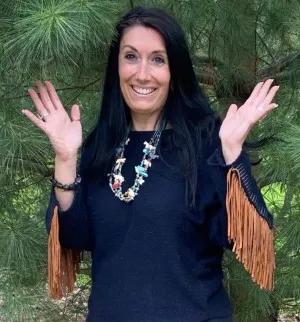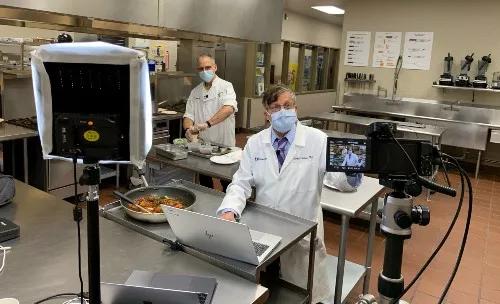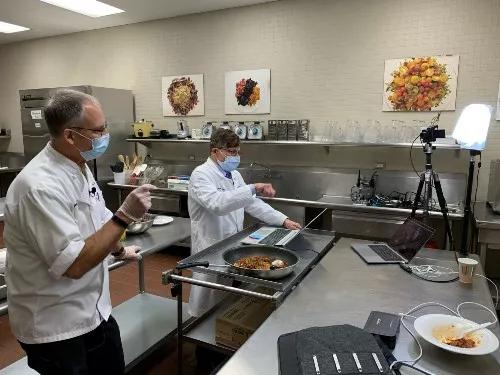
A group of third-year students tuned in for a virtual wellness event at the end of last year that included
breakout groups focused on culinary medicine, physical activity, sleep, yoga and mindfulness meditation,
each led by a Cleveland Clinic expert. Students chose which breakout group they were interested in
attending, with the goal of building healthy habits for themselves and becoming experienced about the
benefits of wellness so that they can share that experience with their patients.

Dr. Cory Chevalier
“One of the most important things we can do to support our students at CCLCM is to not just discuss the importance of focusing on wellness but also to “walk the walk” by providing ongoing opportunities to have students focus on their own wellness in the ways that are meaningful for them,” says Cory Chevalier, MD, Assistant Professor of Medicine and Director of Wellness for CCLCM.
Now all CCLCM students have the chance to work on building healthy habits through two recurring virtual wellness events: 15-minute guided imagery meditation and a culinary medicine workshop. “The sessions are structured in a way that brings the students together, even when virtual, so that we can continue to build our CCLCM family even stronger,” says Dr. Chevalier.
Calming the mind, body
Led by Nazalee O’Hearn, who serves as the Executive Director of the Cleveland Clinic Philanthropy Institute and is also a credentialed life coach, executive coach and certified Reiki master, the weekly guided imagery meditation allows students to reset, re-empower, reflect and refocus their energies and intentions to reduce stress and calm their mind and body.
Nazalee describes the practice as a “not still” meditation. “We use our body while seated, engage in somatic breath work and then move into guided imagery,” she says. Perhaps surprising, meditation can not only be done while sitting, but also when engaged in ordinary activities such as scrubbing the floor, taking a shower, walking through the hospital corridors and gardening.

Nazalee O’Hearn
Guided meditation as a way to reduce stress and calm down quickly isn’t taught structurally in medical school, yet the skills are incredibly useful for healthcare providers, who are at high risk for burnout. To learn the techniques to calm the mind and body down quickly, Nazalee studied Thích Nhât Hanh, a famous Vietnamese Zen master.
“Physicians often are the ones who don’t care for themselves because they’re so busy caring for patients,” says Nazalee. “I’m grateful to be able to teach them this holistic way of coping with stress and calming themselves.”
In normal times, the meditation would likely occur in person, but because it’s virtual, Nazalee assures the students that they can keep their cameras off and mute their microphones so that they can better concentrate.
“I need it as much as everyone who’s showing up, so I tell the students that we are all in practice together. This way, they won’t feel intimidated or that they might fail. You can’t mess this up!”
Nazalee hopes that the students who participate in the guided imagery meditation are able to derive heightened awareness and restoration of their body, mind and spirit. Although 15 minutes may not sound like enough time, she says that you can derive much physical and mental benefit from 15 minutes of meditation.
“It’s a gift you give to yourself.”
Diet is a vital sign
You’ve heard that food is medicine, but have you ever heard that diet is a vital sign? How about that culinary medicine should be a part of every physician’s medical bag? Diet and health are inextricably linked, and healthcare providers must address diet with their patients; otherwise, they are practicing at the margins of what matters the most regardless of what else they do in a clinical setting.
This is the premise behind teaching culinary medicine to our medical students.
“Our goal is to help students develop culinary literacy so that they can prepare healthy meals for themselves and their families, and then pass this knowledge along to their patients,” says Jim Perko Sr., CEC, AAC, Cleveland Clinic Executive Chef. He along with Mike Roizen, MD, Professor of Anesthesiology and Chief Wellness Officer of Cleveland Clinic, created a culinary medicine program that they hope will be eventually integrated into the CCLCM curriculum.

Executive Chef Perko and Dr. Mike Roizen
In a nutshell, culinary medicine combines the evidence-based science of food, nutrition and medicine with the joy and art of cooking. The virtual program they created for students began
in January and is held monthly, during which Dr. Roizen provides the science behind the recipe and Jim shows how to execute it, all from the demonstration kitchen at the Cleveland Clinic Lyndhurst Campus. Students are given information ahead of time about the session including the recipes, shopping list, basic equipment list and any food preparation that is recommended beforehand. During each session, the students can learn how to cook two recipes.
“We use a technique-driven curriculum, kind of like teaching the students how to fish rather than giving them fish,” says Jim. “We teach them cooking techniques such as knife skills and provide them with a culinary medicine toolkit that includes information on nutrition; cooking methods; food safety and sanitation; tips for stocking a pantry; and more.”
Of all the components of wellness, Jim suggests that food choice and calorie intake are among the largest because you have to eat every day.

“You want your diet to fight disease, not feed disease, and your food needs to taste good,” he says. “We tell everyone, especially our patients, that our number one rule is ‘you want to love the foods that love you back!’ Through the culinary
medicine program, students learn culinary techniques such as how to add moisture without fat, sweetness without added sugars, flavor without added sodium and savory density
without meat so they can enjoy meals full of plant-based protein, fiber and nutrients that will fight disease.”
Of course, getting people to change their dietary habits can be an uphill battle. “Food is cultural. To get people to make healthy changes, you have to modify traditional recipes to be healthy while still keeping the traditions they know as well as making new ones,” says Jim.
Student feedback thus far has been overwhelmingly positive. The students are engaged during the cooking demonstrations, asking questions about cooking techniques and equipment, some of which are new to them. The experience has energized both Dr. Roizen and Jim, who plan to continue the monthly sessions through at least the end of 2021.
“We’re confident the students will pay these skills forward to their patients as well as use them to practice self-care. These are skills they’ll have all their life,” says Jim.